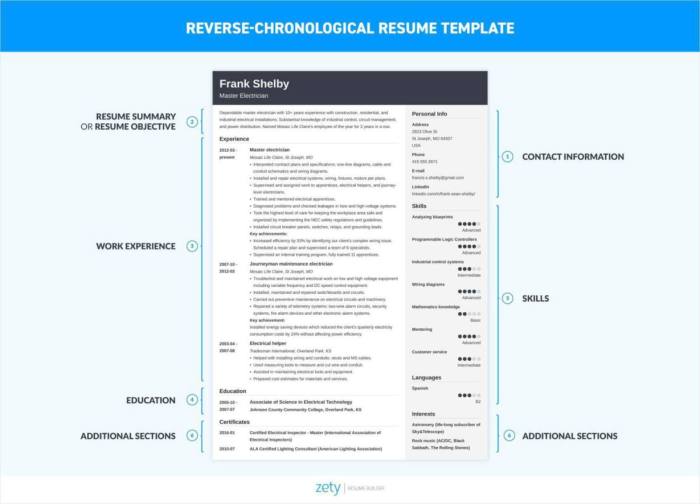Building a Strong Resume sets the stage for your professional journey, guiding you through the essential steps to create a standout document that catches the eye of potential employers. Get ready to dive into the world of resume building with style and substance.
Researching the Position
When applying for a job, it’s crucial to research the position thoroughly to tailor your resume effectively. By understanding the job requirements and key skills needed, you can highlight your qualifications and stand out as a strong candidate.
Identifying Key Skills and Requirements
Before crafting your resume, carefully read the job description to identify the key skills and requirements sought by the employer. Look for specific s or phrases that indicate what the company is looking for in a candidate.
- Make a list of the skills and qualifications mentioned in the job description.
- Highlight the s that are repeated or emphasized throughout the description.
- Pay attention to any specific certifications or experience required for the position.
Matching Your Qualifications
Once you have identified the key skills and requirements, it’s time to match your qualifications with the job description. This step is crucial in demonstrating to the employer that you are the right fit for the position.
- Review your own skills, experiences, and accomplishments that align with the job requirements.
- Showcase relevant achievements and experiences that demonstrate your ability to excel in the role.
- Customize your resume by highlighting how your qualifications directly meet the needs of the position.
Structuring the Resume
When it comes to building a strong resume, the layout plays a crucial role in catching the employer’s attention. A clear and concise resume layout not only makes it easier for the hiring manager to read through your qualifications but also showcases your professionalism and organizational skills.
Sections to Include in a Resume
- Contact Information: Include your full name, phone number, email address, and LinkedIn profile (if applicable) at the top of the resume for easy access.
- Summary: Write a brief summary highlighting your key skills, experiences, and career goals. This section gives the employer a snapshot of who you are as a candidate.
- Work Experience: List your work experience in reverse chronological order, starting with your most recent job. Include the job title, company name, dates of employment, and key responsibilities/accomplishments.
- Education: Mention your educational background, including the degree(s) earned, institution name, graduation year, and any relevant certifications.
Tips on Organizing Information Effectively within Each Section
- Use bullet points to highlight key points in each section, making it easier for the employer to scan through your resume.
- Quantify your achievements with numbers or percentages to showcase your impact in previous roles.
- Tailor each section to the specific job you are applying for, emphasizing relevant skills and experiences that align with the job requirements.
- Keep the layout clean and easy to read, using a consistent font style and size throughout the resume.
- Proofread your resume multiple times to ensure there are no typos or grammatical errors that could detract from your professionalism.
Highlighting Achievements
When it comes to creating a standout resume, highlighting your achievements is key. Employers want to see concrete examples of your skills and accomplishments to determine if you are the right fit for the job. Here are some tips on how to effectively showcase your achievements on your resume:
Include Quantifiable Achievements
- Quantify your achievements with numbers, percentages, or other measurable data to provide concrete evidence of your success.
- For example, instead of saying “increased sales,” you could say “increased sales by 20% in the first quarter.”
- Quantifiable achievements help employers understand the impact you have made in previous roles.
Use Action Verbs
- Use strong action verbs to describe your past experiences and accomplishments, such as “achieved,” “implemented,” “led,” or “improved.”
- Action verbs make your achievements sound more dynamic and engaging, capturing the attention of employers.
- For example, instead of saying “responsible for,” you could say “managed a team of 10 employees.”
Examples of Standout Achievements
- Implemented a new marketing strategy that resulted in a 30% increase in website traffic.
- Achieved a customer satisfaction rating of 95% through improved customer service initiatives.
- Led a team project that reduced production costs by 15% within six months.
Formatting and Design

When it comes to creating a strong resume, the formatting and design play a crucial role in catching the attention of potential employers. Here are some best practices to keep in mind:
Font, Spacing, Alignment
- Choose a clean and professional font like Arial, Calibri, or Times New Roman. Avoid using fancy or decorative fonts that may be difficult to read.
- Ensure proper spacing between sections to make your resume easy to navigate. Use consistent spacing throughout the document.
- Align your text to the left for a clean and organized look. Avoid centering or justifying the text, as it can make the resume harder to read.
Choosing an Appropriate Design
- Consider the industry you are applying to when choosing a design. For creative fields, you can add a pop of color or a unique layout to showcase your creativity. For more traditional industries, stick to a classic and professional design.
- Use a design that complements your content rather than overpowering it. The design should enhance your qualifications and achievements, not distract from them.
Using Bullet Points, Bold Text, and White Space Effectively
- Utilize bullet points to list your achievements and responsibilities in a concise and easy-to-read format. Avoid lengthy paragraphs that may be overwhelming for the reader.
- Use bold text to highlight key information such as job titles, company names, and important achievements. However, do not overuse bold text, as it can lose its impact.
- Make good use of white space to create a balanced and visually appealing resume. White space helps to separate sections and draw the reader’s attention to important details.
Tailoring for Different Roles: Building A Strong Resume
When applying for different job roles, it is crucial to customize your resume to highlight the specific skills and experiences that are most relevant to each position. Tailoring your resume shows the employer that you have taken the time to understand their needs and that you are a good fit for the role.
Emphasizing Relevant Skills and Experiences
To emphasize relevant skills and experiences based on the job requirements, carefully review the job description and identify key qualifications and responsibilities. Make sure to include these s in your resume and provide specific examples of how your past experiences align with what the employer is looking for.
- Use the same language as the job posting to describe your skills and experiences.
- Highlight achievements and projects that demonstrate your qualifications for the role.
- Showcase transferable skills that are applicable across different roles.
Creating Multiple Versions of a Resume, Building a Strong Resume
Creating multiple versions of your resume tailored to different job roles allows you to effectively showcase your qualifications for each position. Consider creating a master resume with all your experiences and then customizing it for each job application by rearranging sections, emphasizing different skills, and including relevant s.
- Save each version of your resume with a clear title indicating the job role or company.
- Update your resume regularly to tailor it to new job opportunities.
- Seek feedback from mentors or professionals in the field to ensure your resume effectively highlights your qualifications for each role.
Proofreading and Editing

When it comes to crafting a strong resume, proofreading and editing are crucial steps to ensure your document is error-free and polished to perfection. Checking for grammar, spelling, and consistency can make a significant difference in how your resume is perceived by potential employers.
Step-by-Step Guide
- Read your resume out loud to catch any awkward phrasing or errors that may have been overlooked.
- Use spell check tools on your computer to identify and correct any spelling mistakes.
- Check for consistency in formatting, such as bullet points, font styles, and alignment throughout the document.
- Ask a friend or mentor to review your resume and provide feedback on areas that may need improvement.
- Take a break and revisit your resume with fresh eyes to catch any final errors before submission.
Significance of Checking Grammar, Spelling, and Consistency
Correct grammar and spelling demonstrate attention to detail and professionalism, which are essential qualities in a candidate. Consistency in formatting ensures a clean and organized appearance, making it easier for recruiters to read and digest the information presented.
Tools and Techniques for a Flawless Final Draft
Utilize online grammar checking tools like Grammarly or Hemingway Editor to identify and correct grammatical errors.
Proofread your resume in a printed format to catch any errors that may be missed on a screen.
Use the “Find and Replace” feature in word processing software to ensure consistency in formatting, such as spacing, punctuation, and font styles.
Consider seeking professional editing services for a thorough review of your resume by experts in the field.
